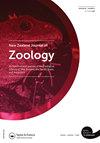Waterfowl hunting wetlands as habitat for two New Zealand eel species
IF 1.1
4区 生物学
Q3 ZOOLOGY
引用次数: 2
Abstract
ABSTRACT New Zealand’s native shortfin eel (Anguilla australis) and endemic longfin eel (Anguilla dieffenbachii) have been negatively affected by wetland habitat loss. However, in Southland, open water wetland habitat has been created by hunters in the form of waterfowl hunting wetlands (duck ponds), habitat which can be utilised by eels. The aim of this study was to estimate the number and biomass of eels supported by Southland duck ponds to highlight the value of hunter-created wetlands as eel habitat. Eel population surveys were conducted in 56 duck ponds located on private agricultural land across Southland. Shortfin eels were found in 28 ponds with an average population size of 22 and biomass of 9.3 kg. Longfin eels were found in 26 ponds with an average population size of nine and biomass of 7.6 kg. Estimates indicate there are 7,013 ± (1761) duck ponds in Southland and they collectively support 36,000 shortfin eels weighing 15,500 kg and 60,000 longfin eels weighing 53,000 kg. Results from this study show that duck hunting ponds are utilised by shortfin and longfin eels.水禽狩猎湿地为两种新西兰鳗鱼的栖息地
新西兰本土短鳍鳗(Anguilla australis)和特有长鳍鳗(Anguilla dieffenbachii)受到湿地栖息地丧失的负面影响。然而,在Southland,猎人以水禽狩猎湿地(鸭塘)的形式创造了开放水域湿地栖息地,这些栖息地可以被鳗鱼利用。本研究的目的是估计南陆鸭塘支持的鳗鱼数量和生物量,以突出猎人创造的湿地作为鳗鱼栖息地的价值。鳗鱼种群调查在位于南地私人农业用地上的56个鸭塘进行。在28个池塘中发现短鳍鳗,平均种群大小为22条,生物量为9.3 kg。在26个池塘中发现了长鳍鳗鱼,平均种群大小为9条,生物量为7.6 kg。据估计,南地共有7,013±(1761)个鸭塘,共饲养着36,000条重达15,500公斤的短鳍鳗鱼和60,000条重达53,000公斤的长鳍鳗鱼。研究结果表明,短鳍鳗鱼和长鳍鳗鱼利用猎鸭池。
本文章由计算机程序翻译,如有差异,请以英文原文为准。
求助全文
约1分钟内获得全文
求助全文
来源期刊
CiteScore
2.80
自引率
0.00%
发文量
20
审稿时长
>12 weeks
期刊介绍:
Aims: The diversity of the fauna of the southern continents and oceans is of worldwide interest to researchers in universities, museums, and other centres. The New Zealand Journal of Zoology plays an important role in disseminating information on field-based, experimental, and theoretical research on the zoology of the region.

 求助内容:
求助内容: 应助结果提醒方式:
应助结果提醒方式:


